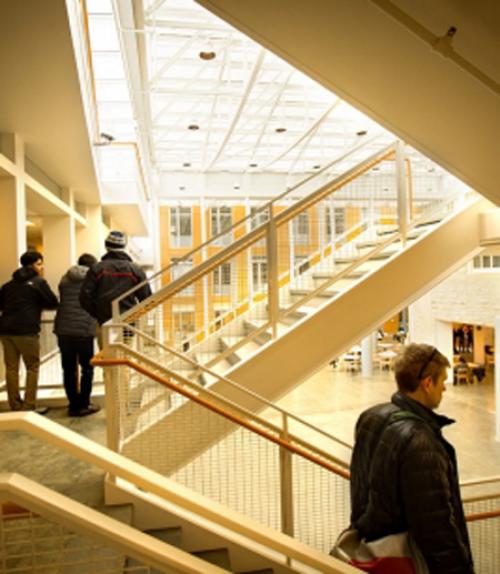Enclosed in glass and welcoming the campus community into a large central atrium leading to Goldwin Smith Hall and the Arts Quad, Klarman Hall is the brand-new showpiece of Cornell’s central campus.
The building at 232 East Ave. also is the new home of three units in the College of Arts and Sciences. Faculty and staff in the Department of Romance Studies finished moving from Morrill Hall into their new offices this week, and Department of Comparative Literature core faculty moved into Klarman from Goldwin Smith. Staff from the college’s Academic Advising and Admissions office moved in December and early January from temporary quarters to Klarman Hall’s south tower.
A view from outside Klarman Hall on January 19th.
“We are thrilled to welcome the occupants of Klarman Hall to the building,” said Gretchen Ritter ’83, the Harold Tanner Dean of Arts and Sciences. “This beautiful new space symbolizes the college’s commitment to the research, scholarship and creative works of our humanities faculty and students.”
Adjoining Goldwin Smith and effectively bringing most of Cornell’s humanities faculty under one roof, the new structure was built at a cost of $61 million raised through philanthropy.
Klarman Hall features a 330-seat auditorium and 120 academic spaces – including individual faculty offices, meeting rooms and seven offices accommodating up to 35 graduate teaching assistants. The two academic departments have access to a 44-seat media room (for courses such as professor Kathleen Long’s Monsters A-X: Aristotle to the X-Files) and a 12-seat seminar room for smaller classes and language instruction.
Two three-story office towers connect with Goldwin Smith’s corridors on each floor and flank the 7,700-square-foot, glass-enclosed atrium, a public gathering space and Klarman Hall’s main entry point. The Temple of Zeus Café recently moved to its new location, opening onto the atrium’s lower level.
“The architects did a good job of making the space both a distinct new building but also seamlessly integrated with Goldwin Smith,” said Scott MacDonald, the college’s senior associate dean for arts and humanities. “The auditorium is one of the critical things we didn’t have available in the college until now. It will be a terrific venue for large lecture classes, formal lectures, performance events, music and other programming.”
Klarman Hall will be a focal point of activities highlighting the humanities throughout the spring semester, leading up to the building’s formal dedication May 26.
“We’re excited about the potential for the atrium space itself,” to be explored in a series of pilot events, MacDonald said. “To have something going on in the public space will attract the attention of people sitting in Zeus or passing through the area, and it will be a constant reminder that this is an academic venue with an intellectual life.”
Romance studies has 18 professorial faculty members, 24 lecturers, a staff of five and a work-study student. “Everyone is really excited to be here,” department chair Marilyn Migiel said. “The common spaces are very, very nice, and the arrangement of space is nice. … Now I feel like we’re all together.”
Comparative literature has 11 full-time faculty members and many others with joint appointments from other departments.
“Most of us are now under the same roof,” said Tracy McNulty, professor and chair of comparative literature, who also teaches French. “The move reintegrates Romance studies with other literature departments, and almost all of the joint-appointed faculty in comparative literature will be in Goldwin Smith or Klarman.”
Assessing her new office Jan. 15, McNulty voiced her approval of windows that nearly reached the ceiling, and having a bus stop nearby and outdoor patio spaces. “Once people are in here, we’ll be getting used to the flow,” she said. “This is going to be good to be in this building, for making informal contacts and for having more of a sense of a common endeavor.”
Among the amenities for faculty and staff are two department lounges that can double as event spaces, with kitchen facilities and videoconferencing equipment.
“It will be a real benefit in finding ways to interact with colleagues from other humanities departments. … That is an immense plus,” Migiel said. “We’ll have receptions and other activities to get people to intermingle and cross-pollinate more.”
Environmentally friendly features of Klarman Hall include sensor-controlled lighting, six green roof areas, vertical spaces that allow daylight into the building, a heat recovery system, radiant heat flooring, the use of lake source cooling and chilled beams, and energy-efficient glazing on the atrium. Two shower rooms in the north tower have been installed for bicycle commuters.






